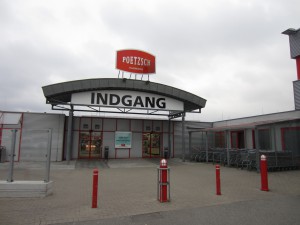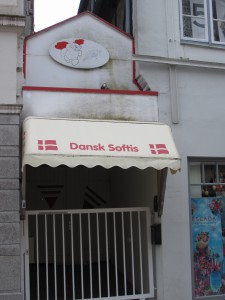Crossing the Border Posted by Bjørn A. Bojesen on Apr 30, 2015 in Uncategorized
Vil du med til grænsen? (Do you want to [go] with [us] to the border?) When two friends offered me en plads i bilen (a spot in the car), I couldn’t miss the chance to go on my first ever grænsehandel (border trade [trip]). Not that I actually needed to købe (buy) anything on the German side of the grænse between Danmark and Tyskland (Germany)… But with so many people talking about their border-crossings, I too wanted to take a look…
Grænselandet (the border district) has always been a ”hot zone” between danskerne (the Danes) and their southern naboer (neighbours). At the ”foot” of the Jylland peninsula are the two old duchies of Slesvig og Holsten (in German: Schleswig und Holstein). At one point of history, they were ruled by the king of Denmark. Later on, they became German. (In 1864, Denmark lost a war against Germany [Prussia] over these territories – to commemorate the 150th anniversary of nederlaget, the defeat, Danish television broadcast the very expensive series ”1864” last year.) In 1920, the people of Nordslesvig (Northern Slesvig) voted to be reunited with Denmark. To celebrate the historical moment, King Christian X crossed the former border at the stream Kongeåen (King’s Stream) on a hvid hest (white horse).
Today, there is a small group of German-speakers in Southernmost Denmark, and a bigger minority of Danish-speakers in Northernmost Germany. The German Danes have their own skoler (schools), butikker (shops) and everything. They’re quite visible, for example in the city of Flensburg, where you find Danish restaurants with little Dannebrog flags, a couple of bilingual street signs, and so on. I think Denmark has been less respectful to its Danish Germans – for example, some days ago, people in Åbenrå tore down a new sign that had added the town’s German name (Apenrade).
So, back to indkøbene (the ”shoppings”): Just at the other side of the border, you pass some enormous warehouses with big parkeringspladser (parking lots). All the cars are clearly from Denmark. The billboards are in Danish. You choose a mall, grab an indkøbsvogn (shopping trolley) and hunt down goods such as øl (beer), slik (candy, sweets) and cigaretter. The lady at the counter speaks Danish.
Why are there so many Danes driving to Germany to shop goods that you can easily get in Denmark? One of my two companions told me it was just part of life for people in Southern Jutland. If you buy large amounts of something – such as dåseøl (canned beer) – you may even save some money: Goods are still a bit cheaper in Germany than in Denmark. But hey, even if they weren’t, nothing really tops the thrill of crossing grænsen, does it? 🙂

Build vocabulary, practice pronunciation, and more with Transparent Language Online. Available anytime, anywhere, on any device.
About the Author: Bjørn A. Bojesen
I was born in Denmark, but spent large parts of my childhood and study years in Norway. I later returned to Denmark, where I finished my MA in Scandinavian Studies. Having relatives in Sweden as well, I feel very Scandinavian! I enjoy reading and travelling, and sharing stories with you! You’re always welcome to share your thoughts with me and the other readers.





